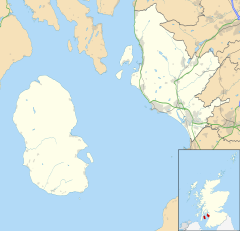Cunninghamhead
| Cunninghamhead | |
|---|---|
| Cunninghamhead shown within North Ayrshire | |
| OS grid reference | NS376418 |
| Council area | |
| Lieutenancy area | |
| Country | Scotland |
| Sovereign state | United Kingdom |
| Post town | KILMARNOCK |
| Postcode district | KA3 |
| Dialling code | 01294 |
| Police | Scottish |
| Fire | Scottish |
| Ambulance | Scottish |
| EU Parliament | Scotland |
| UK Parliament | |
| Scottish Parliament | |
Cunninghamhead is a hamlet on the Annick Water in the Parish of Dreghorn, North Ayrshire, Scotland. The area was part of the old Cunninghamhead estate, and once contained several watermills.
The area is recorded as far back as Pont's / Blaeu's map of 1654 where it is listed as Kunghamhead with a water mill situated nearby. The mill appears on Armstrong's map of 1775. This relatively large mill still exists today as a private house. One of the millers here was a cousin of the Smiths of Coldstream Mill and he taught them the milling craft (Griffith 2004). A track from the mill ran to Byres Farm and thus to the main road (Bartholomew 1912). The leat for the mill ran from a dam on the other side of the 'river loop', then behind the miller's dwelling to finally run under the road to enter the mill site. It is said locally that the dam was removed, after the closure of the mill, by the anglers, who lost salmon to poachers gaffing them as they leapt over it. The leat has been filled in. The course of the lane has changed, once running directly in front of the miller's house. The miller's house is particularly well constructed and ornamented, being owned, like the mill, by the Cunninghamhead Estate until sold after the death of the Kerr sisters.
Just across the Annick Bridge is located a dwelling called 'Tail' on Aitken's 1829 map and Roys map of 1745 - 47. The 1850s OS map shows a dwelling known as Hallgate existing in the middle of the first field on the right after crossing Cunnighamhead Bridge. The only remains are the entrance drive as well as ground depressions and hummocks on the satellite views. Tail and Hallgate appear to be in the same location. An area of well established and biodiverse woodland is present nearby, containing a very large specimen of a Black Poplar (2009), a rare tree in Ayrshire.
Evidence suggests that the name Cunninghame was originally produced as 'Kinikim' and in the 18th century Cunninghamhead Moss was still referred to as Kinnicumheid Moss. A legend is told of how the warlock Laird of Auchenskeith near Dalry set the Devil to make a road across this moss in a single night.(Service, P. 105)
Downstream from the mill was a sawmill fed from a lade which took its water from a dam built on a natural dyke across the Annick. These dykes, bands of especially hard rock, are found at several points crossing the river and many were exploited as the basis for dams, such as also occurred at Dalgarven Mill on the River Garnock. The course and position of most of these dykes is well known as they were a major consideration in the exploitation of coal. Nothing remains of the sawmill other than a vague indication of the lade and the exit onto the river. It had a right-angle turn on its lade, which is a very unusual feature. The point at which the lade changes direction may have been the site of the old mill marked on the 1832 map, but not afterwards, and the lade was then later reused for the sawmill.
...
Wikipedia

